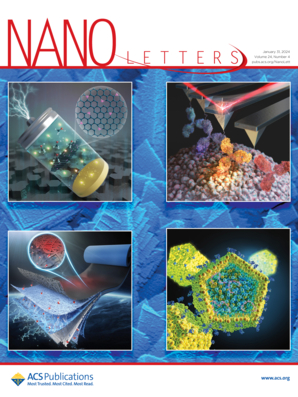Ferroelectric Charged Domain-Wall Synapse for Neuromorphic Computing.
IF 9.6
1区 材料科学
Q1 CHEMISTRY, MULTIDISCIPLINARY
引用次数: 0
Abstract
Inspired by brain neural networks, integrated memory-computing devices are critical to meet the demands of big data and artificial intelligence. This work explores the quasi-continuous modulation of ferroelectric charged domain walls' conductance, which is confined in a topological quad-domain, allowing the charged domain walls to serve as neural synapses. The device mimics synaptic plasticity (long-term potentiation and depression) and shows paired impulse facilitation. In a designed ferroelectric domain-wall neural network, we demonstrate multiplicative, accumulation-additive operations between the input image and the stored response matrix, capable of image processing functions, including triclassification with 100% accuracy. In the neural network simulation, the MINST database and the Cifar-10 database achieve 98.7% and 95.1% recognition rates. The sub-nanosecond polarization switching and the ultrathin (3-5 nm) charged domain walls position them as a promising platform for advancing ultrafast and scalable synaptic devices for low-power (potentially reduced to 0.2 aJ with sub-nanosecond pulse durations) neuromorphic computing systems.用于神经形态计算的铁电畴壁突触。
受大脑神经网络的启发,集成存储计算设备对于满足大数据和人工智能的需求至关重要。这项工作探索了铁电带电畴壁电导的准连续调制,其被限制在拓扑四畴中,允许带电畴壁作为神经突触。该装置模拟突触可塑性(长期增强和抑制),并显示成对的脉冲促进。在设计的铁电畴壁神经网络中,我们演示了输入图像和存储响应矩阵之间的乘法,累积-加性操作,能够实现图像处理功能,包括100%准确率的三分类。在神经网络仿真中,MINST数据库和Cifar-10数据库的识别率分别达到了98.7%和95.1%。亚纳秒极化开关和超薄(3-5纳米)带电畴壁使它们成为一个有前途的平台,用于推进超快和可扩展的突触器件,用于低功耗(亚纳秒脉冲持续时间可能降低到0.2 aJ)神经形态计算系统。
本文章由计算机程序翻译,如有差异,请以英文原文为准。
求助全文
约1分钟内获得全文
求助全文
来源期刊

Nano Letters
工程技术-材料科学:综合
CiteScore
16.80
自引率
2.80%
发文量
1182
审稿时长
1.4 months
期刊介绍:
Nano Letters serves as a dynamic platform for promptly disseminating original results in fundamental, applied, and emerging research across all facets of nanoscience and nanotechnology. A pivotal criterion for inclusion within Nano Letters is the convergence of at least two different areas or disciplines, ensuring a rich interdisciplinary scope. The journal is dedicated to fostering exploration in diverse areas, including:
- Experimental and theoretical findings on physical, chemical, and biological phenomena at the nanoscale
- Synthesis, characterization, and processing of organic, inorganic, polymer, and hybrid nanomaterials through physical, chemical, and biological methodologies
- Modeling and simulation of synthetic, assembly, and interaction processes
- Realization of integrated nanostructures and nano-engineered devices exhibiting advanced performance
- Applications of nanoscale materials in living and environmental systems
Nano Letters is committed to advancing and showcasing groundbreaking research that intersects various domains, fostering innovation and collaboration in the ever-evolving field of nanoscience and nanotechnology.
 求助内容:
求助内容: 应助结果提醒方式:
应助结果提醒方式:


